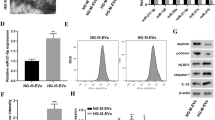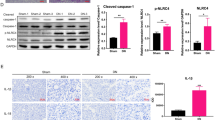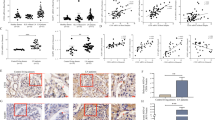Abstract
Hepatitis B virus (HBV) and its related protein, HBV X (HBx), play an important role in podocyte injury in HBV-associated glomerulonephritis (HBV-GN). The microRNA MiR-223 is expressed in several diseases, including HBV-associated disease, while the nucleotide-binding oligomerization domain-like receptor protein 3 (NLRP3) inflammasome plays a major role in pyroptosis. In this study, we investigated the function and mechanism of action of miR-223 in HBx-induced podocyte pyroptosis. A quantitative real-time reverse transcription polymerase chain reaction (qRT-PCR) assay showed that miR-223 was downregulated in HBx-transfected podocytes. Transfection with an miR-223 mimic abolished the expression of the NLRP3 inflammasome and the cytokines that are released as a result of NLRP3 overexpression. Moreover, transfection with HBx and NLRP3 overexpression plasmids increased the expression of pyroptosis-related proteins, especially in the presence of miR-223 inhibitors. Thus, miR-223 downregulation plays an important role in HBx-induced podocyte pyroptosis by targeting the NLRP3 inflammasome, suggesting that miR-223 is a potential therapeutic target for alleviating HBV-GN inflammation.







Similar content being viewed by others
Change history
22 August 2023
A Correction to this paper has been published: https://doi.org/10.1007/s00705-023-05858-8
References
Jiang W, Liu T, Dong H et al (2015) Relationship between serum DNA replication, clinicopathological characteristics and prognosis of hepatitis B virus-associated glomerulonephritis with severe proteinuria by lamivudine plus adefovir dipivoxil combination therapy. Biomed Environ Sci 28:206–213
Diao Z, Ding J, Yin C et al (2013) Purified hepatitis B virus induces human mesangial cell proliferation and extracellular matrix expression in vitro. Virol J 10:300
Dong H, Xu Y, Jiang W et al (2014) Significance of mutations in hepatitis B virus X gene for the pathogenesis of HB-associated glomerulonephritis. Acta Virol 58:278–281
Latz E, Xiao TS, Stutz A (2013) Activation and regulation of the inflammasomes. Nat Rev Immunol 13:397–411
Zhang X, Dong P, Xu L et al (2019) The different expression of caspase-1 in HBV-related liver disease and acts as a biomarker for acute-on-chronic liver failure. BMC Gastroenterol 19:148
Zuo W, Tian R, Chen Q et al (2021) miR-330-5p inhibits NLRP3 inflammasome-mediated myocardial ischaemia–reperfusion injury by targeting TIM3. Cardiovasc Drugs Ther 35:691–705
Zhang H, Du Y, Guo Y et al (2021) TLR4-NLRP3-GSDMD-mediated pyroptosis plays an important role in aggravated liver injury of CD38 sepsis mice. J Immunol Res 2021:6687555
Zhang Q, Zhu D, Dai F et al (2021) MicroRNA-223 suppresses IL-1β and TNF-α production in gouty inflammation by targeting the NLRP3 inflammasome. Front Pharmacol 12:637415
Vilaysane A, Chun J, Seamone ME et al (2010) The NLRP3 inflammasome promotes renal inflammation and contributes to CKD. J Am Soc Nephrol 21:1732–1744
Si J, Yu C, Guo Y et al (2018) Chronic hepatitis B virus infection and risk of chronic kidney disease: a population-based prospective cohort study of 0.5 million Chinese adults. BMC Med 16:93
Ameres SL, Zamore PD (2013) Diversifying microRNA sequence and function. Nat Rev Mol Cell Biol 14:475–488
Lui JC (2017) Regulation of body growth by microRNAs. Mol Cell Endocrinol 456:2–8
Ojha CR, Rodriguez M, Dever SM et al (2016) Mammalian microRNA: an important modulator of host-pathogen interactions in human viral infections. J Biomed Sci 23:74
Cortez MA, Bueso-Ramos C, Ferdin J et al (2011) MicroRNAs in body fluids—the mix of hormones and biomarkers. Nat Rev Clin Oncol 8:467–477
Ishii H, Kaneko S, Yanai K et al (2020) MicroRNAs in podocyte injury in diabetic nephropathy. Front Genet 11:993
Haneklaus M, Gerlic M, O’Neill LA et al (2013) miR-223: infection, inflammation and cancer. J Intern Med 274:215–226
Yu Y, Dong H, Sun J et al (2022) Hepatitis B virus X mediates podocyte pyroptosis by regulating the ROS/NLRP3 signaling pathway in hepatitis B virus-associated glomerulonephritis. Iran J Basic Med Sci 25:103–109
Xiang H, Zhu F, Xu Z et al (2020) Role of inflammasomes in kidney diseases via both canonical and non-canonical pathways. Front Cell Dev Biol 8:106
Stienstra R, van Diepen JA, Tack CJ et al (2011) Inflammasome is a central player in the induction of obesity and insulin resistance. Proc Natl Acad Sci USA 108:15324–15329
Liao MT, Chang MH, Lin FG et al (2011) Universal hepatitis B vaccination reduces childhood hepatitis B virus-associated membranous nephropathy. Pediatrics 128:e600–e604
Yu DY, Moon HB, Son JK et al (1999) Incidence of hepatocellular carcinoma in transgenic mice expressing the hepatitis B virus X-protein. J Hepatol 31:123–132
Fischer FA, Chen KW, Bezbradica JS (2021) Posttranslational and therapeutic control of gasdermin-mediated pyroptosis and inflammation. Front Immunol 12:661162
Hou Y, Wang Q, Han B et al (2021) CD36 promotes NLRP3 inflammasome activation via the mtROS pathway in renal tubular epithelial cells of diabetic kidneys. Cell Death Dis 12:523
Singh GB, Kshirasagar N, Patibandla S et al (2019) Nicotine instigates podocyte injury via NLRP3 inflammasomes activation. Aging (Albany NY) 11:12810–12821
Awad F, Assrawi E, Louvrier C et al (2018) Inflammasome biology, molecular pathology and therapeutic implications. Pharmacol Ther 187:133–149
Lei B, Liu J, Yao Z et al (2021) viaNF-κB-induced upregulation of miR-146a-5p promoted hippocampal neuronal oxidative stress and pyroptosis TIGAR in a model of Alzheimer’s disease. Front Cell Neurosci 15:653881
Yin R, Zhu X, Wang J et al (2019) MicroRNA-155 promotes the ox-LDL-induced activation of NLRP3 inflammasomes via the ERK1/2 pathway in THP-1 macrophages and aggravates atherosclerosis in ApoE−/− mice. Ann Palliat Med 8:676–689
Xu D, Zhang X, Chen X et al (2020) Inhibition of miR-223 attenuates the NLRP3 inflammasome activation, fibrosis, and apoptosis in diabetic cardiomyopathy. Life Sci 256:117980
Hong J, Bhat OM, Li G et al (2019) Lysosomal regulation of extracellular vesicle excretion during d-ribose-induced NLRP3 inflammasome activation in podocytes. Biochim Biophys Acta Mol Cell Res 1866:849–860
Wu H, Huang T, Ying L et al (2016) MiR-155 is involved in renal ischemia-reperfusion injury via direct targeting of FoxO3a and regulating renal tubular cell pyroptosis. Cell Physiol Biochem 40:1692–1705
Zhang Q, Conley SM, Li G et al (2019) Rac1 GTPase inhibition blocked podocyte injury and glomerular sclerosis during hyperhomocysteinemia via suppression of nucleotide-binding oligomerization domain-like receptor containing pyrin domain 3 inflammasome activation. Kidney Blood Press Res 44:513–532
Tan Y, Chen Q, Li X et al (2021) Pyroptosis: a new paradigm of cell death for fighting against cancer. J Exp Clin Cancer Res 40:153
Lu TX, Rothenberg ME (2018) MicroRNA. J Allergy Clin Immunol 141:1202–1207
Kim J, Yao F, Xiao Z et al (2018) MicroRNAs and metastasis: small RNAs play big roles. Cancer Metastasis Rev 37:5–15
Sultana C, Rosca A, Ruta S (2019) Correlation between miR-125b expression and liver fibrosis in patients with chronic hepatitis C. Hepat Mon 19:e84615
Zankar S, Trentin-Sonoda M, Viñas JL et al (2021) Therapeutic effects of micro-RNAs in preclinical studies of acute kidney injury: a systematic review and meta-analysis. Sci Rep 11:9100
Zheng X, Zhong Q, Lin X et al (2021) Transforming growth factor-β1-induced podocyte injury is associated with increased microRNA-155 expression, enhanced inflammatory responses and MAPK pathway activation. Exp Ther Med 21:620
Ye D, Zhang T, Lou G et al (2018) Role of miR-223 in the pathophysiology of liver diseases. Exp Mol Med 50:1–12
Johnnidis JB, Harris MH, Wheeler RT et al (2008) Regulation of progenitor cell proliferation and granulocyte function by microRNA-223. Nature 451:1125–1129
Wang X, Seo W, Park SH et al (2021) MicroRNA-223 restricts liver fibrosis by inhibiting the TAZ-IHH-GLI2 and PDGF signaling pathways via the crosstalk of multiple liver cell types. Int J Biol Sci 17:1153–1167
Maruyama D, Kocatürk B, Lee Y et al (2021) MicroRNA-223 Regulates the development of cardiovascular lesions in LCWE-induced murine Kawasaki disease vasculitis by repressing the NLRP3 inflammasome. Front Pediatr 9:662953
Bauernfeind F, Rieger A, Schildberg FA et al (2012) NLRP3 inflammasome activity is negatively controlled by miR-223. J Immunol 189:4175–4181
Kleivi SK, Bottai G, Naume B et al (2015) A serum microRNA signature predicts tumor relapse and survival in triple-negative breast cancer patients. Clin Cancer Res 21:1207–1214
Lai X, Eberhardt M, Schmitz U et al (2019) Systems biology-based investigation of cooperating microRNAs as monotherapy or adjuvant therapy in cancer. Nucleic Acids Res 47:7753–7766
Ling H, Fabbri M, Calin GA (2013) MicroRNAs and other non-coding RNAs as targets for anticancer drug development. Nat Rev Drug Discov 12:847–865
Funding
This work was supported by the National Natural Science Foundation of China (grant number NSFC 81870494), the Chinese Society of Nephrology (grant number 20010080800), and the Qingdao Outstanding Health Professional Development Fund (grant number 2020-2022).
Author information
Authors and Affiliations
Contributions
Yani YU, Hui DONG, and Wei JIANG designed the experimental idea and wrote the main manuscript text. Yue ZHANG, Jingyi SUN, and Baoshuang LI performed the experiments and collected the relevant data. Yueqi CHEN, Moxuan FENG, and Xiaoqian YANG finished the formal analysis and investigation. Shengbo GAO prepared Figures 1-5. All authors reviewed the manuscript.
Corresponding author
Ethics declarations
Conflict of interest
None.
Ethical approval
Approval was granted by the Affiliated Hospital of Qingdao University. All methods were performed in accordance with the relevant guidelines and regulations.
Additional information
Handling Editor: Zhongjie Shi.
Publisher's Note
Springer Nature remains neutral with regard to jurisdictional claims in published maps and institutional affiliations.
The original online version of this article was revised: Figure 2C replaced with the updated version.
Rights and permissions
Springer Nature or its licensor (e.g. a society or other partner) holds exclusive rights to this article under a publishing agreement with the author(s) or other rightsholder(s); author self-archiving of the accepted manuscript version of this article is solely governed by the terms of such publishing agreement and applicable law.
About this article
Cite this article
Yu, Y., Dong, H., Zhang, Y. et al. MicroRNA-223 downregulation promotes HBx-induced podocyte pyroptosis by targeting the NLRP3 inflammasome. Arch Virol 167, 1841–1854 (2022). https://doi.org/10.1007/s00705-022-05499-3
Received:
Accepted:
Published:
Issue Date:
DOI: https://doi.org/10.1007/s00705-022-05499-3




